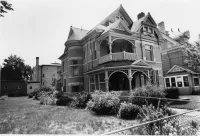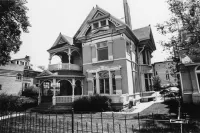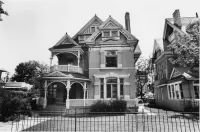Share what you know,
and discover more.
Share what you know,
and discover more.
Oct 21, 1982

-

- Charmaine Bantugan
National Register of Historic Places - Flower-Vaile House (See Also:Swallow Hill Historic District)
Statement of Significant: The Flower-Vaile House at 1610 Emerson Street in Denver is historically significant for its association with the Joel F. Vaile family, leaders in the social and economic development of both the state of Colorado and the city and County of Denver. The house is an excellent example of late 19th century electic style residential architecture, and was designated as a Denver Landmark on October 13, 1981 by the City Council, upon recommendation of the Planning and Landmark commissions. The house was described by Richard R. Brettel in Historic Denver: The Architects and the Architecture 1858-1893 as a prime example of "decorative or surface style eclecticism added to the basic Queen Anne Street house --very common in Denver by the mid to late 1880's." The original owner of 1610 Emerson was John S. Flower, a prominent Denver real estate developer and close friend of Mayor Robert Speer. Flower commissioned the leading Denver architectural firm of Balcombe and Rice to design the residence with D. S. Gray as the carpenter/contractor. The building permit, #1795 issued December 9, 1889, listed the cost of the house as $10,200. (Flower again teamed with Balcombe and Rice in 1892 for the construction of 1618 Ogden Street, another residence in the eclectic style, which received National Register listing in September 1980.) Flower sold 1610 Emerson in July 1890 to the prominent Denver attorney Joel F. Vaile as part of a large transaction in which Flower acquired from Vaile several large tracts in Arapahoe County. Born in Centerville, Indiana, in March 1848, Vaile was the son of William H. Vaile, an Indiana attorney. Joel F. Vaile graduated from Oberlin College with honors in civil engineering which he later taught at Berea College in Kentucky. He returned to Indiana to read the law with his father, and was admitted to the bar in 1874. In 1880, he was elected as an Indiana delegate to the Republican National Convention in Chicago. In 1882, Joel Vaile migrated to Denver. He soon became a partner with Judge J.A. Bentley, practicing law from an office in the Symes Building. Vaile later formed a law partner- ship with Senator Edward 0. Wolcott and rented what became his permanent office, Room 420 of the Equitable Building. The Colorado Bar Association elected Vaile as president in 1899, and when the Denver Bar Association was formally incorporated in 1903, Vaile was elected as president for 1903-04. In 1906 Vaile established the law firm Vaile and Watterman. The firm's name changed several times until it became Vaile, MacAllister and Vaile and Vaile in 1890 when Joel's son William N. Vaile became a partner.
National Register of Historic Places - Flower-Vaile House (See Also:Swallow Hill Historic District)
Statement of Significant: The Flower-Vaile House at 1610 Emerson Street in Denver is historically significant for its association with the Joel F. Vaile family, leaders in the social and economic development of both the state of Colorado and the city and County of Denver. The house is an excellent example of late 19th century electic style residential architecture, and was designated as a Denver Landmark on October 13, 1981 by the City Council, upon recommendation of the Planning and Landmark commissions. The house was described by Richard R. Brettel in Historic Denver: The Architects and the Architecture 1858-1893 as a prime example of "decorative or surface style eclecticism added to the basic Queen Anne Street house --very common in Denver by the mid to late 1880's." The original owner of 1610 Emerson was John S. Flower, a prominent Denver real estate developer and close friend of Mayor Robert Speer. Flower commissioned the leading Denver architectural firm of Balcombe and Rice to design the residence with D. S. Gray as the carpenter/contractor. The building permit, #1795 issued December 9, 1889, listed the cost of the house as $10,200. (Flower again teamed with Balcombe and Rice in 1892 for the construction of 1618 Ogden Street, another residence in the eclectic style, which received National Register listing in September 1980.) Flower sold 1610 Emerson in July 1890 to the prominent Denver attorney Joel F. Vaile as part of a large transaction in which Flower acquired from Vaile several large tracts in Arapahoe County. Born in Centerville, Indiana, in March 1848, Vaile was the son of William H. Vaile, an Indiana attorney. Joel F. Vaile graduated from Oberlin College with honors in civil engineering which he later taught at Berea College in Kentucky. He returned to Indiana to read the law with his father, and was admitted to the bar in 1874. In 1880, he was elected as an Indiana delegate to the Republican National Convention in Chicago. In 1882, Joel Vaile migrated to Denver. He soon became a partner with Judge J.A. Bentley, practicing law from an office in the Symes Building. Vaile later formed a law partner- ship with Senator Edward 0. Wolcott and rented what became his permanent office, Room 420 of the Equitable Building. The Colorado Bar Association elected Vaile as president in 1899, and when the Denver Bar Association was formally incorporated in 1903, Vaile was elected as president for 1903-04. In 1906 Vaile established the law firm Vaile and Watterman. The firm's name changed several times until it became Vaile, MacAllister and Vaile and Vaile in 1890 when Joel's son William N. Vaile became a partner.
Oct 21, 1982
National Register of Historic Places - Flower-Vaile House (See Also:Swallow Hill Historic District)
Statement of Significant:The Flower-Vaile House at 1610 Emerson Street in Denver is historically significant for its association with the Joel F. Vaile family, leaders in the social and economic development of both the state of Colorado and the city and County of Denver. The house is an excellent example of late 19th century electic style residential architecture, and was designated as a Denver Landmark on October 13, 1981 by the City Council, upon recommendation of the Planning and Landmark commissions.
The house was described by Richard R. Brettel in Historic Denver: The Architects and the Architecture 1858-1893 as a prime example of "decorative or surface style eclecticism added to the basic Queen Anne Street house --very common in Denver by the mid to late 1880's."
The original owner of 1610 Emerson was John S. Flower, a prominent Denver real estate developer and close friend of Mayor Robert Speer. Flower commissioned the leading Denver architectural firm of Balcombe and Rice to design the residence with D. S. Gray as the carpenter/contractor. The building permit, #1795 issued December 9, 1889, listed the cost of the house as $10,200. (Flower again teamed with Balcombe and Rice in 1892 for the construction of 1618 Ogden Street, another residence in the eclectic style, which received National Register listing in September 1980.)
Flower sold 1610 Emerson in July 1890 to the prominent Denver attorney Joel F. Vaile as part of a large transaction in which Flower acquired from Vaile several large tracts in Arapahoe County. Born in Centerville, Indiana, in March 1848, Vaile was the son of William H. Vaile, an Indiana attorney. Joel F. Vaile graduated from Oberlin College with honors in civil engineering which he later taught at Berea College in Kentucky. He returned to Indiana to read the law with his father, and was admitted to the bar in 1874. In 1880, he was elected as an Indiana delegate to the Republican National Convention in Chicago.
In 1882, Joel Vaile migrated to Denver. He soon became a partner with Judge J.A. Bentley, practicing law from an office in the Symes Building. Vaile later formed a law partner- ship with Senator Edward 0. Wolcott and rented what became his permanent office, Room 420 of the Equitable Building. The Colorado Bar Association elected Vaile as president in 1899, and when the Denver Bar Association was formally incorporated in 1903, Vaile was elected as president for 1903-04. In 1906 Vaile established the law firm Vaile and Watterman. The firm's name changed several times until it became Vaile, MacAllister and Vaile and Vaile in 1890 when Joel's son William N. Vaile became a partner.
Posted Date
Jul 28, 2023
Historical Record Date
Oct 21, 1982
Source Name
National Register of Historic Places
Source Website
Delete Story
Are you sure you want to delete this story?












